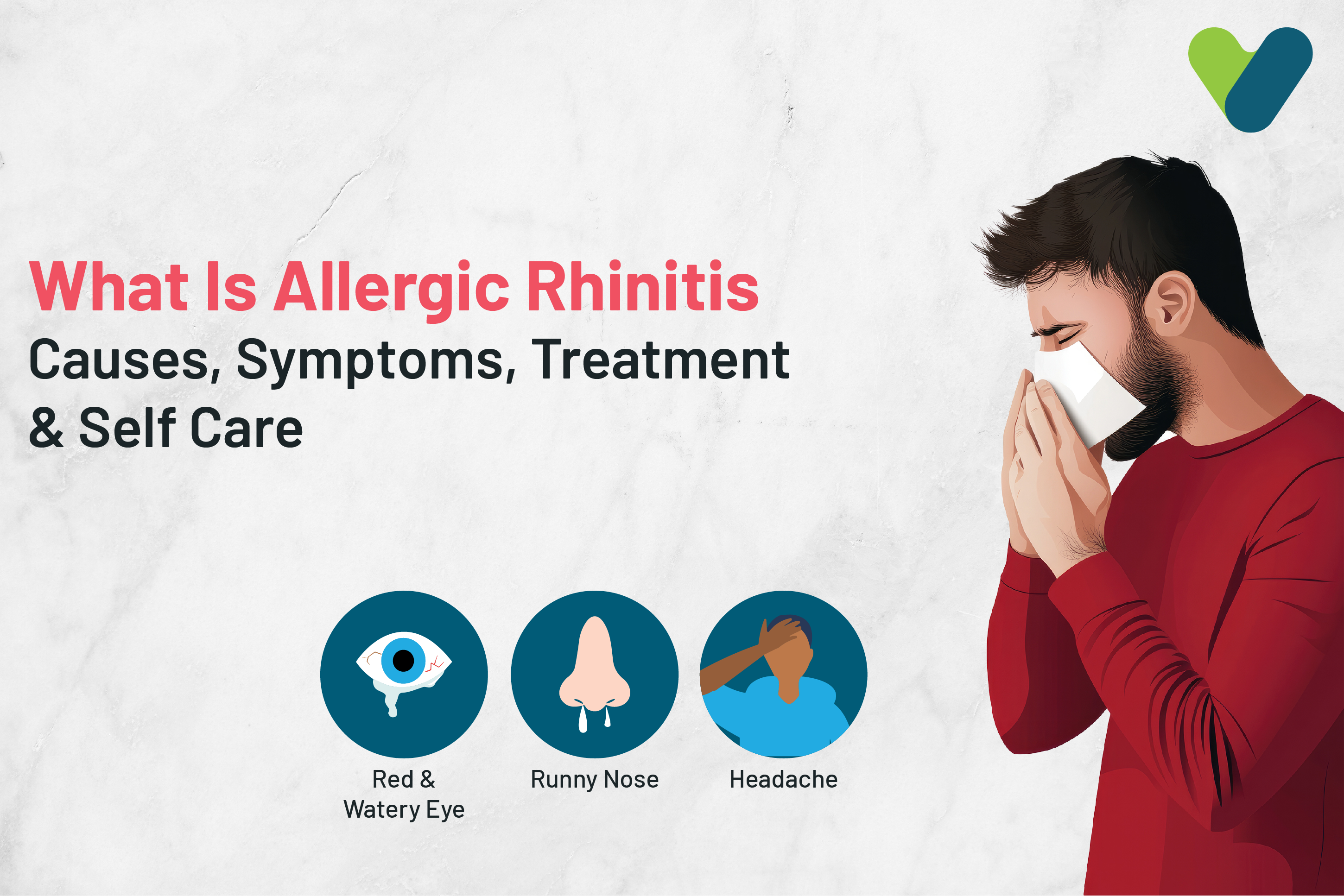Have you ever felt a sniffle, an irritation in your eyes, or tired when the seasons change? You may be experiencing symptoms of the common cold randomly throughout the year. Allergic Rhinitis, also called Hay Fever, is to blame for that sniffle. Allergic rhinitis can make life a nuisance. The symptoms are similar to the common cold i.e. itchy eyes, runny nose, congestion, etc. This is a common condition that affects at least 30% of adults and 40% of children globally.
If allergic rhinitis is bringing you down or if you are a parent trying to manage your child’s allergy symptoms, read further as we discuss the causes of allergic rhinitis, the accompanying symptoms, and how you can get treated.
What is Allergic Rhinitis (Hay Fever)?
Allergic Rhinitis, also known as Hay Fever, is a condition that resembles a cold. The symptoms of allergic rhinitis include a runny nose, itchy eyes, congestion, sinus pressure, and more. On the outside, allergic rhinitis looks almost exactly like the common cold. However, there is a difference: Allergic rhinitis is caused by allergies, whereas the common cold is caused by a virus. Allergic rhinitis causes your nasal passages to become inflamed. Allergens like pollen, dust mites, animal dander, or mold trigger your immune system, which views them as an intruder and reacts accordingly. It releases histamines, which cause symptoms like sneezing, a runny nose, and itching.The name “hay fever” might make you think that it has something to do with hay or having a fever; neither is true. There is very rarely a fever, and hay does not cause the symptoms. Allergic Rhinitis is called hay fever because allergy symptoms were most common during the hay harvesting season.
What triggers allergic rhinitis?
There are several triggers for allergic rhinitis. Since it affects individuals throughout the year and sometimes with changing seasons, the specific trigger differs from person to person, and from season to season. The most common allergens include:- Air Pollutants
- Dust Mites
- Pollen
- Mold Spores
- Pet Dander
When do people typically experience hay fever symptoms?
Hay fever is most common during seasonal change. Pollen count in the air is generally high during spring, summer, and autumn. Those who are not allergic to pollen, but are allergic to dust mites or pet dander, may experience allergic rhinitis at any point during the year.Spring is the most common time for allergens like pollen to start causing cold-like symptoms. Tree pollen is the most common trigger during spring. With summer, grass pollen is most common. During autumn, ragweed pollen is a major pollen-related trigger for allergic rhinitis.
Specific weather conditions can worsen allergic rhinitis symptoms. If the weather is warm, dry, or windy, it can worsen pollen-related symptoms. If you spend long hours indoors during winter, without opening the windows, you can increase allergens exposure.
How common is allergic rhinitis (hay fever) in India?
Allergic rhinitis or hay fever is a fairly common condition in India. It affects roughly 20% to 30% of the population. Typically, hay fever develops right when the seasons change, especially during spring. While seasonal change-related hay fever is common in India, the country has also undergone significant industrial change in recent decades.With increasing urbanization, pollution has increased, indoor air quality has decreased, and there is limited awareness of allergic rhinitis. Hay fever may feel worse during the night, sometimes even leading to obstructive sleep apnea.
Types of Allergic Rhinitis
Although allergic rhinitis is a common condition, everybody’s triggers are not the same. Allergic Rhinitis can be broadly classified into three categories:- Seasonal Allergic Rhinitis: Seasonal allergic rhinitis develops at the cusp of seasonal change. The seasons when you are most likely to develop allergic rhinitis include spring, summer, and autumn. The pollen count shifts significantly during these seasons, especially spring. Pollen is the most common allergen that triggers seasonal allergic rhinitis.
- Perennial Allergic Rhinitis: Perennial allergic rhinitis is triggered by everyday allergens like dust mites, pet dander, or mold. If these allergens exist in your home, it is easier to clean and maintain the area. However, you cannot control the spread of these allergens outside your home. Dust mites and pet dander are the most common triggers for perennial allergic rhinitis. These allergens are present everywhere and affect a large section of the population. With pet dander, the most common animals to cause hay fever are cats and dogs.
- Occupational Allergic Rhinitis: Occupational Rhinitis affects a select part of the population. This type of hay fever refers to one’s working environment. Allergens like wood dust, latex, or even flour at a bakery can trigger hay fever symptoms. Baker’s asthma refers to allergy-like symptoms triggered by inhaling flour, which is most common in baking-related industries.
Allergic Rhinitis (Hay Fever) Causes
Allergic Rhinitis is essentially your immune system reacting to an irritant in the air. Allergens are microscopic and difficult to avoid. This is why hay fever is so common. The microscopic allergens are easy to inhale through the nose or mouth.Allergens are not inherently harmful. They may not be life-threatening, but they can be a hindrance in your day-to-day life. Your immune system is only trying to fight off what it perceives as an intruder. It releases a chemical called histamine that causes inflammation in your mucus membranes. Essentially, the immune system goes into overdrive trying to expel the allergen.
The most common causes of allergic rhinitis (hay fever) include:
- Dust mites: commonly found indoors, on carpets, drapes, beddings, furniture, etc. Any fabric indoors can hold on to dust mites.
- Pollen: Pollen from trees, grass, weeds, flowers, and more. Pollen triggers hay fever mostly during seasonal changes.
- Pet dander: Most common pet dander-related allergens come from cats and dogs. Their fur, skin, saliva, and excretion can release microscopic particles in the air. These particles are then inhaled by humans, leading to allergic reactions like itchy eyes, sneezing, and congestion.
- Cockroaches: Cockroaches, too, can cause allergic rhinitis (hay fever). This might be a lesser-known cause, but it is possible. Their saliva and waste can trigger allergic rhinitis.
- Mold: Mold spores are not seen to the naked eye. They spread fast in da amp environment. If you have mold indoors, it is crucial that you dry the damp space as soon as possible or call a professional mold exterminator. Inhaling mold spores can be dangerous to human and animal health. It can trigger cold-like symptoms easily. Growing mold can be difficult to spot, which makes it a difficult allergen to expel.
Allergic Rhinitis (Hay Fever) symptoms
Outdoor allergic rhinitis worsens during seasonal changes, whereas indoor allergic rhinitis can worsen if the space is not cleaned. During winter, if you don’t open your windows to air out the house, symptoms of hay fever can get worse. Let’s dive into the symptoms of hay fever:- Nasal stuffiness or congestion is a common symptom, and usually one of the first indicators of allergic rhinitis.
- You may find your nose, eyes, and throat feel itchy.
- This is typically followed by a runny nose or persistent sneezing.
- Your eyes may begin to water and become bloodshot.
- You may feel sinus pressure or sinus-related headaches.
- Exhaustion is a common symptom of hay fever.
- Your immune system triggers the production of mucus when faced with an allergen, so your nose and throat may have more mucus than usual.
- Coughing, wheezing, or difficulty breathing are also common signs of allergic rhinitis (hay fever).
How can I tell the difference between hay fever and a cold?
Symptoms of a common cold and hay fever overlap quite a bit. Some differences between the two include:- Red or itchy eyes: It is not common to have red or itchy eyes when you have a cold. Allergic rhinitis, on the other hand, can make your eyes water and itch, turning them red in the process.
- Virus vs allergen: A common cold is caused by viruses or bacteria. Hay fever is caused by allergens.
- Time: A common cold will pass within a week after taking medications and resting. Hay fever can only be resolved if the allergen is completely removed from the air. As long as the allergen exists, hay fever will exist.
Who is at risk for hay fever?
Hay fever is most likely to affect you if you have a parent or close relative who has allergies. Allergies are inherited. People with respiratory conditions like asthma or skin conditions like eczema are more likely to develop hay fever. Asthma and eczema can make you sensitive to contracting other allergic symptoms.Diagnosis for Allergic Rhinitis
Your doctor will first assess your symptoms. They may ask you what symptoms you are experiencing and evaluate you to rule out other conditions. They may perform allergy tests. A blood allergy test looks for antibodies in your blood sample. A blood allergy test is called an immunoglobulin E test. It is the most common blood allergy test that can be used to detect most allergies, including food allergies.Allergies can also be tested using the skin prick or intradermal test. During this test, your doctor may prick you with a small needle that introduces various allergens to your body. Using this method, they can track how your body reacts to various allergens. Typically, your body will start reacting to these allergens in 15 to 30 minutes, becoming red, itchy, and irritated.
How do you cure allergic rhinitis permanently?
Allergic rhinitis symptoms can be managed with medications and ridding the air of allergens. While hay fever symptoms can become a hindrance to daily life, the symptoms are manageable. Your doctor may prescribe nasal sprays, eye drops, pills, or injections to deal with the symptoms of allergic rhinitis. Talk to your doctor before taking any medication.Antihistamines
When your immune system gets into fight mode, it releases histamines as a reaction to allergens. Antihistamines work by blocking these histamines. Antihistamines can be consumed as pills, liquids, eye drops, and nasal sprays. Inhalers also carry antihistamines. Antihistamines can make you drowsy, so it is best to avoid alcohol or other stimulants when taking these medications. Driving is also not recommended if you are taking antihistamines.
Corticosteroid Nasal Sprays
Nasal sprays and inhalers work by reducing inflammation in the nasal passage and throat. They can help relieve hay fever symptoms like congestion, a runny nose, sneezing, etc. Side effects of corticosteroid nasal sprays may include headaches, nosebleeds, and coughing.
Decongestants
Decongestants come as pills, liquids, or nasal sprays. They do what the name suggests: decongest. They can help clear your sinuses and nasal passages. Possible side effects include a slight elevation in blood pressure, headaches, trouble sleeping, and irritability. Nasal sprays can be addictive, so it is best to take them only for the prescribed course.
One of the best and long-lasting ways to treat allergic rhinitis is to help your body get used to the allergen. Your doctor may give you a shot with a small dose of the allergen, increasing the dose with each shot. This helps your body get acquainted with the allergen. Think of it as exposure therapy. The longer you are exposed to the allergen, the less it affects you.
Allergic Rhinitis Self-Care
Self-care during allergic rhinitis includes reducing exposure and managing your symptoms. Allergic rhinitis will stay in your system as long as the responsible allergens are present in the air. You can learn to identify the allergens that trigger your allergic rhinitis. This can help you avoid the triggers altogether or use medications in time to manage your symptoms.If you have perennial allergic rhinitis, ensure to keep your home and other indoor spaces clean. You can use allergen-proof bedding to avoid dust mites collecting on the fabric. Keep pets out of your bedroom and bathe them regularly. Change their litter spaces regularly and install air purifiers.
For mold-related allergic rhinitis, ensure the moisture within your home is controlled. If you find mold, treat it immediately because mold spreads quickly and can be harmful in the long run.
When to see a doctor?
See a doctor if you have fever symptoms that are not manageable with lifestyle changes. If your allergic rhinitis symptoms begin significantly impacting your daily life, including sleep, you should seek further medical attention immediately.If you have asthma or eczema, it is crucial that you are careful about monitoring your symptoms. Both conditions can worsen your allergic rhinitis, or the allergic rhinitis can exacerbate the asthma and eczema symptoms.


